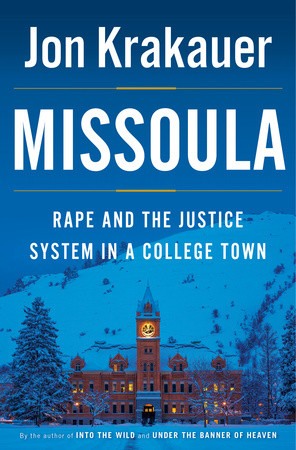Jon Krakauer’s newest book, Missoula: Rape and the Justice System in a College Town, he traces the stories of several young women “in an effort to understand what deters so many rape victims from going to the police.” There aren’t necessarily more rapes in Missoula than in other, similar-sized towns; it just happened to be on his radar after some media outlets wrote about the local police department and the University of Montana’s poor handling of rape cases. Missoula deals primarily with acquaintance rape–which, according to RAINN, accounts for about 80% of all rape cases. Those numbers are only from rapes that are reported–about 70% are not–and even then, even when women report and go through the arduous and often humiliating process of reporting and questioning and trials, only 2% of rapists ever see the inside of a prison cell.
This past Sunday, the latest episode of Game of Thrones contained a scene in which one of the main characters, Sansa Stark, was raped by her new husband. Stark is one of the three remaining children of Ned Stark, who once ruled the kingdom where she has returned to live. Her loss has already been thorough, and in the book, she does not return to this kingdom in the north, does not marry Ramsay Bolton, does not get raped by him while her childhood acquaintance Theon Grayjoy looks on in horror. The GoT writers decided to add this scene into the show, making this the third television-only rape of a female character on the show.

Sophie Turner, who plays Sansa Stark on HBO’s Game of Thrones | Photo by Suzi Pratt via Flickr (http://bit.ly/1FwVZsv)
There are reasons to choose to depict rape or not, and this one has spurred a lot of outrage. We already knew that Ramsay Bolton was a torturous psychopath, and some objected to how graphic his torture of Theon Grayjoy was. Character development wasn’t the reason behind the decision to show this rape (which we witness primarily through the faces of Sansa Stark and Theon Grayjoy, both in indescribable pain); nor was plot advancement since the books move on just fine without this particular element. Others claim it was necessary for verisimilitude–so that the show looks like everyday life in Game of Thrones. Some have pushed back against that, pointing out that this is a show with magic and dragons and, therefore, not very tuned into real life at all to begin with. But even if the hope here was to show the horrors of real life in Winterfell, the kingdom Sansa came home to, there are ways to imply rape without actually walking the viewer through it. In fact, there is something strange about the decision to show only the faces of the victim and the onlooker, never focusing on the rapist, that creates the illusion of a disembodied evil force, rather than a person committing a terrible violation and a crime.
This illusion is the thing I’m most worried about when it comes to how we deal with rape, both in real life and in popular culture. We live in an era in which there is rape without rapists. In one of the most haunting parts of Missoula, Krakauer recalls the scene at the county courthouse where Allison Huguet, a rape victim, is watching several community members come to the defense of her (confessed) rapist, Beau Donaldson. One man, a family friend of both Donaldson’s and Huguet’s, testifies that “Beau is a friend. I don’t want him to go to prison.” Donaldson’s sex ed teacher from high school recommends a “second chance” for Donaldson.
This is what happens when we use rape as sloppy punctation in storytelling, a lá Game of Thrones, or when we think only evil-seeming men with weapons in dark alleys can be thought of as real rapists. I was reminded of that again this week when I read about how Columbia University’s president refused to shake hands with Emma Sulkowicz, the student who has been carrying her mattress around campus as a form of protesting how poorly the school has handled her accusation of rape. A (male, Christian) friend of mine tweeted a link about this and the only response it got was from a fellow Christian man who tweeted a story in which Sulkowicz’s alleged rapist denied all charges, the implication being, “not so fast! Don’t believe her without hearing from him, too.” But how many men have ever confessed quickly and humbly to rape? As Christians, we should know above all the capacity of the heart for deceit.
Religious people–those of us who believe that human brings have a soul and that there is more to life than just our daily lived experiences–should be at the front of the charge against rape. Many Christians–the same ones who would never watch Game of Thrones because it involves swearing, sex, and violence–will question the victim’s narrative without a second thought, despite the fact that very few rape claims (somewhere between 2-8%) are ever falsified. Women are too often either disbelieved or discarded, and rapists can come in all shapes and sizes–even the most unexpected.





